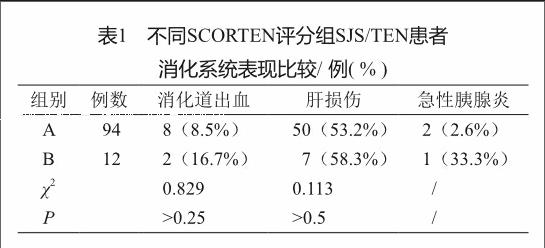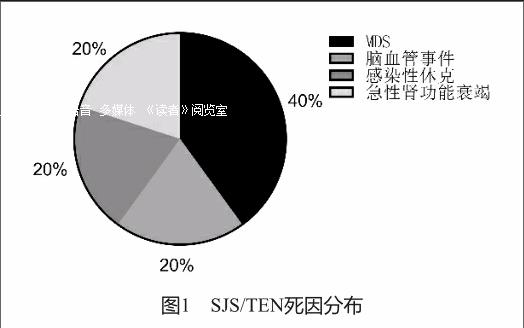Stevens-Johnson综合征/中毒性表皮坏死松解症中的消化系统受累调查
2017-05-10訾元云张成峰陈坚
訾元云+张成峰+陈坚



摘 要 目的:探讨Stevens-Johnson综合症(SJS)和中毒性表皮坏死松解症(TEN)的消化系统表现。方法:回顾分析复旦大学附属华山医院皮肤科2001年1月至2016年8月收治的106例SJS/TEN患者的临床资料(SJS 99例,TEN 7例),按SCORTEN评分0~2分分为A组、3~4分为B组,比较消化系受累有无差异。结果:伴消化道出血10例(9.4%),肝损伤57例(53.8%),急性胰腺炎3例(2.8%)。按SCORTEN评分分组比较,差异无统计学意义。死亡共5例(4.7%),TEN组与SJS组相比有统计学差异(28.6% vs 3.0%,P<0.01)。结论:SJS/TEN患者中消化道出血、肝损伤及急性胰腺炎均有一定比例的发生率,其中尤以肝损伤常见。SJS/TEN有较严重的并发症及一定的死亡率,值得警惕。
关键词 Stevens-Johnson综合征 中毒性表皮坏死松解症 SCORTEN评分 消化系统并发症
中图分类号:R593.1 文献标识码:C 文章编号:1006-1533(2017)07-0047-04
Survey of digestive tract complications in Stevens-Johnson syndrome and toxic epidermal necrolysis
ZI Yuanyun1, ZHANG Chengfeng2, CHEN Jian3*(1. Department of Gastroenterology, Anning Peoples Hospital, Kunming 650300, China; 2. Department of Dermatology, Huashan Hospital, Fudan University, Shanghai 200040, China; 3. Department of Gastroenterology, Huashan Hospital, Fudan University, Shanghai 200040, China)
ABSTRACT Objective: To explore the digestive system involvement in Stevens Johnson Syndrome (SJS) and toxic epidermal necrolysis (TEN). Methods: The clinical data of 106 cases of SJS/TEN patients (99 cases of SJS and 7 cases of TEN) selected from Huashan Hospital were retrospectively analyzed. The patients were divided into group A if their SCORTEN scores were 0-2 and group B if SCORTEN scores were 3 or 4 and their digestive system involvement was compared. Results: The incidence of the involvement was 9.4% (10 cases) for GI tract bleeding, 53.8% (57 cases) for liver injury and 2.8% (3 cases) for acute pancreatitis. There were 5 cases of death (4.7%) while the mortality rate was 3.0% in SJS and 28.6% in TEN (3/96 vs 2/7, P<0.01). Conclusion: There are more than 70% of SJS/TEN patients accompany with different digestive tract complications, in which liver injury is the most common. SJS/TEN usually accompanies with severer complications and a certain mortality, which are worthy of vigilance.
KEY WORDS Stevens-Johnson syndrome; toxic epidermal necrolysis; SCORTEN score; digestive tract complications
史蒂文斯-约翰逊综合征(Stevens-Johnson syndrome,SJS)和中毒性表皮坏死症(toxic epidermal necrolysis,TEN)属于同一个疾病谱系(SJS/TEN),是由免疫复合物所致的一种变态反应性疾病。该组疾病大多由藥物过敏引起,有明确用药诱因的患者占75%左右(主要是抗生素、非甾体抗炎药、抗癫痫药等),还有大约25%的患者没有药物诱因;后者可能是由感染引起,潜在病因有:病毒感染、肺炎支原体感染和肿瘤;尚有个别病例无法确定病因[1]。在亚洲国家,SJS/TEN的发病率大约为每年8/100 万,在白种人则约为0.4/100 万~7/100 万[2]。该疾病虽发生率低,但死亡率高。SJS 的死亡率报告为平均1%~5%,TEN则高达25%~35%[3]。根据受累体表面积的多少可将SJS/TEN分为SJS、SJSTEN重叠及TEN。SJS为受累体表面积小于l0%,SJSTEN重叠为10%~30%,TEN 为大于30%[4]。临床表现除了广泛的体表皮肤受累外,尚可累及口腔、眼部、胃肠道、呼吸道、泌尿生殖道等系统的黏膜,表现为结膜炎、消化道出血、肝损伤、急性胰腺炎、呼吸系统感染、尿痛、血尿、肾功能衰竭等,甚至因严重器官功能衰竭而死亡[5-7]。为了进一步分析SJS/TEN中消化系统受累的情况以及其与SCORTON评分的相关性,本研究回顾分析了复旦大学附属华山医院皮肤科自2001年1月至2016年8月收治的106例SJS/TEN患者的临床资料(SJS 99例,TEN 7例),以期对SJS/TEN的皮肤外表现(尤其是消化系统并发症)有更深入的认识。
1 材料与方法1.1 数据收集
采用“史蒂文斯-约翰逊综合征”或“中毒性表皮坏死症”作为搜索关键词,在复旦大学附属华山医院病案室2001年1月至2016年8月的数据库中共检索出121例患者,剔除资料不完整者,所剩106例SJS/TEN患者中SJS 99例,TEN 7例;其中男性62例,女性44例,男女比例为1.4∶1.0;年龄16~88岁,平均年龄(49.94±18.39)岁。
SCROTEN评分能有效地反映TEN患者的预期死亡率,可对患者病情及预后进行评估[8-9],SCROTEN评分包括7 个参数:①年龄> 40 岁;②心率>120 次;③合并有癌症或血液系统肿瘤;④表皮剥脱> 10%体表面积;⑤血尿素氮>10 mmol/L;⑥血糖>14 mmol/L;⑦血 PaCO2< 20 mmol/L。若符合其中 0~1 个危险因素提示死亡率为 3.2%,2 个危险因素为 12.1%,3个危险因素为35.3%,4 个危险因素为58.3%,5个或更多危险因素则为 90%。该评分要求在入院 24 h 内完成。其中大于3分者建议入住ICU。本研究因病例数所限及统计处理需要,分别将伴有消化系统症状患者按SCROTEN评分0~2分分为A组(94例)及3~4分分为B组(12例)进行比较分析。
1.2 统计方法
2 结果
2.1 消化系统表现
消化道出血总发生率为9.4%,而肝损伤为53.8%,差异均无统计学意义 (表1)。急性胰腺炎3例,总发生率为2.8%,其中1例SCORTEN评分为4分(1/3,发生率33.3%),2例为1分(2/78,发生率为2.6%),因病例数少未行进一步比较分析。
2.2 死亡病例分析
106例住院患者共死亡5例,死亡率为4.7%(5/106),其中SJS 组3例,死亡率为3.0%(3/99)(1例死于MDS,1例为蛛网膜下腔出血、脑梗,1例为感染性休克),TEN组 2例,死亡率为28.6%(2/7)(1例为急性肾功能衰竭,1例为MDS),二组死亡率有显著性差异(P<0.01)。根据死亡原因分布绘制死因分布图(图1)。消化系统表现(肝损伤、消化道出血及急性胰腺炎)均未成为患者致死的主要原因。
3 討论
SJS/TEN患者消化道出血主要表现为大便隐血阳性或便血,较少出现呕血。其发病原因主要考虑疾病本身导致的胃肠道黏膜受累。例如Von Boxberg等[10]报道1例TEN死亡后行尸检的患者,发现整个消化道都有粘膜剥脱。此外尚需考虑既往及目前合并用药情况(如非甾体类抗炎药、糖皮质激素、PPI等)及急性应激等综合因素的影响[11]。SCORTEN评分虽可反映病情的严重程度,Beck等[12]报道单凭SCORTEN评分预测患者的致残率或死亡率并不足够。本研究也发现单凭SCORTEN评分未能较好地预测消化道出血的发生率,故病程中需严密观察粪便情况,常规行粪隐血实验早期发现隐匿的消化道出血,预防性使用质子泵抑制剂当属必要,尤其是针对糖皮质激素使用者。
SJS/TEN患者并发肝损伤比例较高,约为50%左右,但其发生率未随SCORTEN评分增高而增高。肝功能异常可发生在治疗前及治疗过程中,究其原因除本病也可能导致胰胆管的内皮损伤或继发于肠黏膜屏障损害后的的内毒素血症以外,仍不能忽视因使用药物(如抗菌药物、非甾体抗炎药、抗癫痫药等)导致的药物性肝损。病程中应密切监测肝功能变化,一旦发现肝损,应立即停用相关可疑药物并予以积极保肝治疗。
急性胰腺炎在SJS/TEN患者中发生率较低,其发生率与SCORTEN评分之间的相关性尚待大样本资料观察分析。其相关发病原因考虑:①药物性胰腺炎(相关药物包括抗生素、非甾体抗炎药、免疫抑制剂等);②SJS/ TEN患者胰胆管内皮受累后胰管堵塞,胰腺内压增高引发胰腺炎[7];③SJS/TEN患者肠道黏膜充血、水肿、糜烂,黏膜通透性明显升高,容易发生持续的高淀粉酶血症,需要与急性胰腺炎相鉴别[13]。
消化道出血、肝损伤及急性胰腺炎作为消化系统的常见并发症,严重时可直接导致患者死亡。本研究资料显示SJS及TEN仍有一定的病死率,其死亡率与既往报道类似,但TEN组的病死率明显高于SJS组,考虑与前者的皮肤黏膜受累范围更广,多脏器受累更常见有关[14]。本研究中,5例死亡患者分别有血液循环系统(MDS、感染性休克)、中枢神经系统(脑梗)、肺脏(呼吸衰竭)、肾脏(肾衰竭)的受累。消化道出血、肝损伤及急性胰腺炎等消化系并发症虽未直接导致患者死亡,但其势必影响或者加重SJS/TEN患者的病程及预后,增加患者疾病负担。故病程中应密切监测病情,对于已经发生的消化系统或其他系统的严重并发症,除积极监测患者生命体征外,必要时可在包括皮肤科、消化科、肾脏科、呼吸科、眼科、泌尿科等多学科医生的参与下制定相关的综合治疗方案以降低患者病死率[15-16]。
参考文献
[1] 李诚让, 吴建兵, 马一平, 等. 重症多形红斑和StevensJohnson综合征[J]. 中华皮肤科杂志, 2014, 47(5): 375-377.
[2] Hazin R, Ibrahimi OA, Hazin Ml, et al. Stevens-Johnson syndrome pathogenesis, diagnosis, and management[J]. Ann Med, 2008, 40(2): 129-138.
[3] Mockenhaupt M. Severe cutaneous adverse reactions[M]// Beurgdorf WHC, Plewig G, Wolff HH, et al. Braun-Falco-F Dermatology (3rd Edition). Berlin: Springer, 2009: 473-483.
[4] Bastuji-Garin S, Rzany B, Stern RS, et al. Clinical classification of cases of toxic epidermal necrolysis, StevensJohnson syndromes, and erythema multiforme[J]. Arch Dermatol, 1993, 129(1): 92-96.
[5] Petukhova TA, Maverakis E, Ho B, et al. Urogynecologic complications in Stevens-Johnson syndrome and toxic epidermal necrolysis: presentation of a case and recommendations for management[J]. JAAD Case Rep, 2016, 2(3): 202-205.
[6] Chantaphakul H, Sanon T, Klaewsongkram J. Clinical characteristics and treatment outcome of Stevens-Johnson syndrome and toxic epidermal necrolysis[J]. Exp Ther Med, 2015, 10(2): 519-524.
[7] Bequignon E, Duong TA, Sbidian E, et al. Stevens-Johnson syndrome and toxic epidermal necrolysis: ear, nose, and throat description at acute stage and after remission[J]. JAMA Dermatol, 2015, 151(3): 302-307.
[8] Bansal S, Garg VK, Sardana K, et al. A clinicotherapeutic analysis of Stevens-Johnson syndrome and toxic epidermal necrolysis with an emphasis on the predictive value and accuracy of SCORe of Toxic Epidermal Necrolysis[J]. Int J Dermatol, 2015, 54(1): e18-e26.
[9] Roongpisuthipong W, Prompongsa S, Klangjareonchai T. Retrospective analysis of corticosteroid treatment in StevensJohnson syndrome and/or toxic epidermal necrolysis over a period of 10 years in Vajira Hospital, Navamindradhiraj University, Bangkok[J/OL]. Dermatol Res Pract, 2014: 237821. doi: 10.1155/2014/237821.
[10] Von Boxberg C, Breidenbach K, H?hler H, et al. Undesired drug effects after taking chlormezanone (Muscle Trancopal) with lethal results[J]. Dtsch Med Wochenschr, 1998, 123(28-29): 866-870.
[11] Liu W, Nie X, Zhang L. A retrospective analysis of Stevens-Johnson syndrome/toxic epidermal necrolysis treated with corticosteroids[J]. Int J Dermatol, 2016, 55(12): 1408-1413.
[12] Beck A, Quirke KP, Gamelli RL, et al. Pediatric toxic epidermal necrolysis: using SCORTEN and predictive models to predict morbidity when a focus on mortality is not enough[J]. J Burn Care Res, 2015, 36(1): 167-177.
[13] Dylewski ML, Prelack K, Keaney T, et al. Asymptomatic hyperamylasemia and hyperlipasemia in pediatric patients with toxic epidermal necrolysis[J]. J Burn Care Res, 2010, 31(2): 292-296.
[14] Dodiuk-Gad RP, Chung WH, Valeyrie-Allanore L, et al. Stevens-Johnson syndrome and toxic epidermal necrolysis: an update[J]. Am J Clin Dermatol, 2015, 16(6): 475-493.
[15] Papo M, Valeyrie-Allanore L, Razazi K, et al. Renal replacement therapy during Stevens-Johnson syndrome and toxic epidermal necrolysis: a retrospective observational study of 238 patients[J]. Br J Dermatol, 2016. doi: 10. 1111/bjd. 14934.
[16] Lee HY, Walsh SA, Creamer D. Long term complications of Stevens-Johnson syndrome/toxic epidermal necrolysis: The spectrum of chronic problems in patients who survive an episode of SJS/TEN necessitates multi-disciplinary follow up[J]. Br J Dermatol, 2017, doi: 10. 1111/bjd. 15360.
